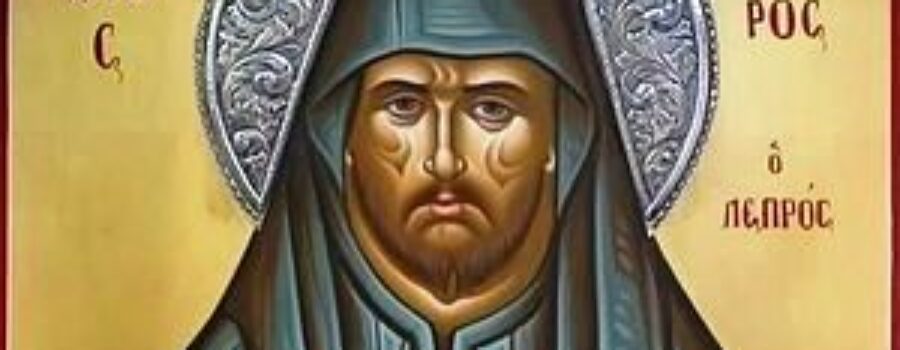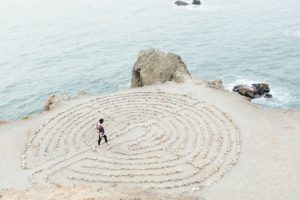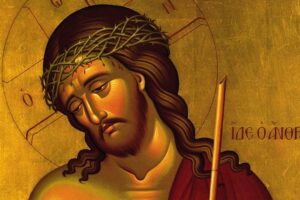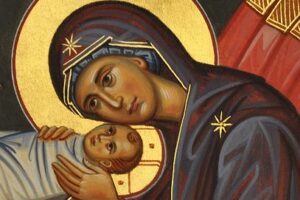St. Nikephoros the Leper (feast day January 4) is a twentieth-century saint who suffered from leprosy for many decades. He has emerged as a major saint to turn to during this time of pandemic, after word spread that he had appeared to an elderly man in Greece in early March, telling him not to fear the virus because he would protect and heal all those who have faith and turn to him in prayer.
Father Nikephoros (Nicholas Tzanakakis in the world) was born in 1890 in a mountainous village in Khania, Greece, which enjoyed a healthy climate, with beautiful forests, rich waters, gorges, and caves.
His parents were simple and pious villagers who died when he was still a young child, leaving him as an orphan. So, at the age of thirteen, he left his home. His grandfather, who had undertaken to raise him, went to Khania to work there in a barbershop in order to learn the job. At that time, young Nicholas showed the first signs of Hansen’s disease, better known as leprosy. The lepers were isolated on the island of Spinalonga because leprosy was a contagious disease and it was treated with fear and dismay.
Nicholas was sixteen years old when signs of the disease began to become more conspicuous, so he left on a boat to Egypt in order to avoid being confined to Spinalonga. He remained in Alexandria, working in a barbershop again, but the signs of the disease became more and more apparent, especially on his hands and face. Through the intervention of a cleric, he went to Chios, where there was a church for lepers at that time, and the priest was Father Anthimos Vagianos, later Saint Anthimos (February 15).
Nicholas arrived in Chios in 1914 at the age of twenty-four. In the leper hospital of Chios, which was a complex with many homesteads, there was a chapel of Saint Lazarus, where the wonderworking icon of the Panagia of Ypakoe (Theotokos of Obedience) was kept. In this space, the course of virtues was opened for Nicholas. Within two years, Saint Anthimos considered him ready for the angelic Schema and tonsured him with the name Nikephoros. The disease progressed and evolved in the absence of suitable drugs, causing many large lesions (a drug would later be discovered in 1947).
Father Nikephoros lived with unquestioning, genuine obedience to his spiritual father, and with austere fasting, working in the gardens. He also recorded the miracles of Saint Anthimos, which he had witnessed with his own eyes, many of which were related to the deliverance of those possessed by demons.
There was a special spiritual relationship between Saint Anthimos and the monk Nikephoros, who always remained close to him. Father Nikephoros prayed at night for hours on end, making countless metanias (bows or prostrations). He did not quarrel with anyone, nor injure anyone’s heart, and he was the master chanter of the temple. Because of his illness, however, he slowly lost his sight, and so he chanted the troparia and the Epistles from memory.
The Chios leprosarium was closed in 1957, and the remaining patients, together with Father Nikephoros, were sent to Saint Barbara’s home for lepers in Athens. At that time, Father Nikephoros was about 67 years old. His members and his eyes were completely altered and distorted by the disease.
There, Father Eumenios also lived there at the home for lepers. He also suffered from Hansen’s disease, but with the medication he received, he had been completely cured. However, he decided to remain in the home for lepers for the rest of his life near his fellow sufferers, caring for them with much love. Thus he submitted to Father Nikephoros, to whom the Lord had given many gifts as a reward for his patience. A crowd of people gathered in the humble cell of the leper Nikephoros to obtain his prayers. Here are some testimonies of those who met him:
“While he was prostrate with wounds and pains, he did not complain, but he showed great patience.” “He had the charisma of consoling those who were sad. His eyes were permanently irritated, and he had limited sight. He also had stiffness in his hands and paralysis in his lower limbs. Nonetheless, he endured all of this in the sweetest, meek, smiling, delightful way, and he was also pleasant and lovable.” “His face, which was eaten away by the marks of his illness, and his wounds, shone. It was a joy for those who saw this destitute and seemingly feeble man saying, May His holy name be glorified.”
Father Nikephoros reposed on January 4, 1964, at the age of 74. After three years, his holy relics were exhumed and found to be fragrant. Father Eumenios and other believers reported many cases where miracles occurred by calling on Saint Nikephoros to intercede with God.
The life of Saint Nikephoros was a brilliant example and model for everyone. He was pleasing to God because he had endured so much. For this reason, we have many testimonies that our saint received from the Holy Spirit the gift of discernment and a host of other charisms. We should note that most of the miracles are recorded, and today the saint gives generous help to anyone in need. Surely there will be many more miracles that not have not yet been made manifest.
Troparion, Tone 1
All the angels were astonished by the struggles and strict asceticism of the Venerable Nikephoros the Leper; / for like another Job, patiently enduring his pain, he glorified God, / Who has crowned him now with glory, distinguishing him through miracles. / Rejoice, instructor of monastics! / Rejoice, beacon of light! / Rejoice, for a delightful fragrance pours forth from your relics!
Kontakion, Tone 8
The valiant athlete of endurance and fortitude, / the steadfast diamond of patience and long-suffering was tried by affliction and sickness, / and in this way he glorified the Most High God, let us extol Nikephoros the Leper, / saying unto him: Rejoice, O namesake of victory!
—Courtesy of OrthodoxChristian.com and OCA.org




